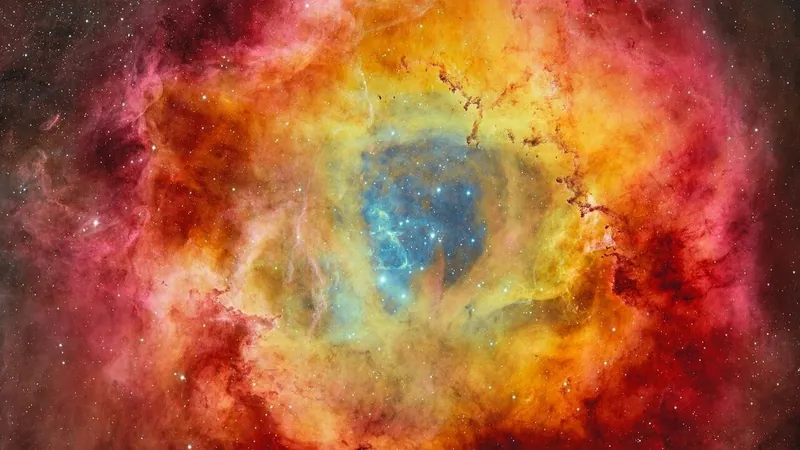
Stunning Imagery of the Rosette Nebula Reveals Cosmic Masterpiece
2024-10-01
Author: Ting
Prepare to be mesmerized! The Rosette Nebula, an intricate cosmic tapestry, has been brilliantly captured by the high-resolution Dark Energy Camera (DECam), showcasing the vibrant interplay of hot, youthful stars and the molecular gas that envelops them.
Rising into the northern hemisphere's winter sky, the Rosette Nebula, nestled in the constellation Monoceros (the Unicorn), sits southeast of the iconic Orion and is elegantly enclosed within the Winter Triangle formed by the illustrious stars Sirius, Procyon, and Betelgeuse. Located approximately 5,000 light-years from Earth, the Rosette Nebula can sometimes be challenging to spot with the naked eye due to its low surface brightness, appearing as a ghostly ring through a telescope. However, its true brilliance comes alive in long-exposure photographs like this astonishing image captured at the Cerro Tololo Inter-American Observatory in Chile.
With an incredible 500-megapixel resolution, DECam reveals the Rosette Nebula in all its magnificent detail. Its designation as the "Rosette" is truly fitting; the nebula resembles a gigantic floral wreath, stretching an impressive 130 light-years across.
The core of the Rosette Nebula is a vibrant region of star formation surrounding the star cluster NGC 2244, home to several hot and massive young stars. Unlike the surrounding nebula, which often requires larger telescopes to observe, this star cluster can be glimpsed by amateur astronomers with binoculars or even seen with the naked eye from dark locations.
What sets the Rosette Nebula apart is the powerful radiation and stellar winds being emitted from its central star cluster, which ionize the surrounding gas. This radiation effectively clears a vast cavity in the nebula's center and causes the various gases to emit their characteristic colors, which is why we refer to it as an "emission nebula." The striking image uses filters to capture the emission from hydrogen (radiating red), oxygen (giving off a golden-yellow hue) near the central void, and ionized silicon along its edges (appearing pink). There are likely even more gases hidden within this colossal molecular cloud, yet to be detected.
The darker regions within the image highlight dense clouds of dust, often obscuring nascent stars, and are whimsically referred to as "elephant trunks" due to their elongated forms. One prominent feature, the so-called "Wrench Trunk," spirals gracefully, twisting along the magnetic field lines of the nebula. Additionally, the Rosette is peppered with Bok globules—clumps of cold dust that may be nurturing newly forming star systems. These compact structures are vital for the birth of stars, including brown dwarfs, which are lesser stars that lack the necessary mass to initiate hydrogen fusion.
The breath-taking artistry of the Rosette Nebula not only enriches our understanding of star formation but also captivates every sky gazer and astrophotographer. As this celestial wonder graces the winter night sky, it serves as a reminder of the beauty and complexity of the universe. Prepare to be enchanted!

 Brasil (PT)
Brasil (PT)
 Canada (EN)
Canada (EN)
 Chile (ES)
Chile (ES)
 España (ES)
España (ES)
 France (FR)
France (FR)
 Hong Kong (EN)
Hong Kong (EN)
 Italia (IT)
Italia (IT)
 日本 (JA)
日本 (JA)
 Magyarország (HU)
Magyarország (HU)
 Norge (NO)
Norge (NO)
 Polska (PL)
Polska (PL)
 Schweiz (DE)
Schweiz (DE)
 Singapore (EN)
Singapore (EN)
 Sverige (SV)
Sverige (SV)
 Suomi (FI)
Suomi (FI)
 Türkiye (TR)
Türkiye (TR)